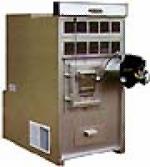Search engine visitors - click here to access entire "$ensible Home" web site
Click here to see a descriptive illustration of several designs of central corn, pellet and wood-burning furnaces.
Dear Jim: I have heard a lot about using homegrown renewable fuel, such as corn, pellets, or wood, to heat my entire home. Are there any types of convenient-to-use central furnaces that use these homegrown fuels? - Tom G.

A: In today's world with our heavy dependency on foreign energy supplies, it makes sense to use as many homegrown fuels as possible. This is not only good for our economy, but also for our nation's security.
For the greatest convenience, install a furnace or boiler that burns corn or wood pellets (cherry pits, wheat or rye also work). These operate from a standard wall thermostat and automatically feed in the proper amount of corn or pellets from a large hopper to keep your house comfortably warm.
Corn, that is unacceptable for animal feed because it is scorched, the wrong size or mildewed, can be purchased inexpensively. With the high efficiency of these furnaces, waste corn is a low-cost fuel for homes. Wood pellets, made for sawdust, are priced higher, but are still reasonable.
New, high-tech wood-burning furnaces and boilers can also heat an entire house with little inconvenience and mess. Some models burn for 48 hours on one load of firewood. They can be attached to your existing forced-air duct or hot water system and heat your home like a standard gas or oil furnace.
The most convenient models couple the wood-burning furnace or boiler with a gas- or oil-fired backup unit. When the firewood burns down, the furnace automatically switches the gas or oil burners on. This changeover happens so quickly and smoothly that you cannot detect when the backup kicks in.
Some models have the backup gas or oil burner built into the wood-burning furnace firebox (can be used to start the wood too). Other, equally efficient systems have a completely separate standard gas or oil furnace coupled with the wood burner. You may be able to still use your old furnace.
One unique central furnace design has a real fireplace built into the side of it. With the furnace located immediately behind a wall, the fireplace, with glass bi-fold doors, extends through the wall into the adjacent room.
Another option is to install an outdoor furnace or boiler. These are often designed to resemble a small storage shed. The advantage of an outdoor model is it can be located near the firewood pile (more than 100 feet from your house) and there is no mess, noise or smoke indoors.
Insulated ducts can be used to bring heated air to your house, but a boiler often makes more sense for an outdoor unit. The hot water can be used for baseboard heat, infloor radiant heat or in the furnace blower section.
Instant Download Update Bulletin No. 418 - buyer's guide of 17 indoor and outdoor corn, pellet and wood forced-air furnace and hot water boiler manufacturers listing heat outputs, log sizes, hopper sizes, blower speeds, tanks capacities, features, prices, illustrations of many models, a wood heat evaluation worksheet and a firewood heat content chart.
Dear Jim: We removed some of our air register vents to do some painting and found dirt particles and insulation bits behind them. We have a central air cleaner, so how did the dirt get back there? - Connie T.
A: Your problem is not unusual and it probably creates a lot of dust inside your home. The most common cause is a leaky air duct system.
The air blowing through the duct system can create a vortex at leaky spots, especially around the registers. This vortex draws air and dust from inside the dirty walls into the air flow. Get some aluminum tape or duct-sealing compound and seal any leaky joints you can reach.